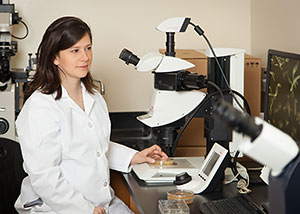UH-led Study Published in Current Biology, Supported by NSF Grants
Nobody likes a cheater. In a recent study, a University of Houston evolutionary biologist and her collaborators found that while cheaters do not take over populations, they also cannot ever fully be removed.

Elizabeth Ostrowski, University of Houston evolutionary biologist, observes multicellular
structures of Dicty, a soil-living, social amoeba, to study genes related to cooperation
and conflict.By identifying how diverse societies prevent or cope with cheating, the researchers
say they can identify general principles about how to promote cooperation and prevent
conflict. Led by Elizabeth Ostrowski, an assistant professor in biology and biochemistry
at UH’s College of Natural Sciences and Mathematics, the work was a collaboration
between a number of different laboratories specializing in the study of Dictyostelium
discoideum, or Dicty, which is a species of soil-living, social amoeba commonly referred
to as a slime mold.
Supported by grants from the National Science Foundation, their findings are described in a paper titled “Genomic signatures of cooperation and conflict in the social amoeba,” appearing June 15 in Current Biology, a scientific bimonthly journal published by Cell Press. The article published online June 4. Ostrowski is the lead author.
“Cheating is a part of every society, including human society. There are always individuals who get ahead without doing their fair share of the work,” Ostrowski said. “Understanding how societies can remain harmonious and reconcile what is best for the individual versus the group can help us understand what the attributes of successful societies are.”
To do this, Ostrowski and her colleagues examined the molecular evolution of genes important for cheating behaviors in Dicty. In this organism, individual amoebae gather together upon starvation to form a multicellular organism. During this process, approximately 20 percent of the cells altruistically give up their lives to form a rigid stalk that supports and helps the survivors to disperse as hardy spores. Some individuals, however, cheat, failing to form the stalk themselves, yet benefitting from its production by others.
Genetic screens identified more than 100 genes that impact cheating behaviors in Dicty. The researchers used genome sequencing to identify naturally occurring DNA differences in these genes and molecular evolution analyses to test different scenarios about the dynamics of these genes in natural populations.
“For this project, we sequenced 20 Dicty strains we had isolated from the soil in the eastern U.S. We then looked for variation in 140 genes implicated in social behavior, comparing them to the rest of the genome to see if the social genes were evolving differently,” said senior author Joan Strassmann, the Charles Rebstock Professor of Biology in Arts & Sciences at Washington University in St. Louis. “Disabling these 140 genes turned a cooperating amoeba into a cheater.”
The scientists framed their study by defining several hypothetical scenarios for the evolutionary dynamics of cheating behaviors in Dicty. They examined it from a standpoint of an arms race, a stalemate or a mutation-selection scenario. Each made different, testable predictions about DNA diversity in and near the social genes. In the arms race scenario, epidemics of cheating and resistance successively sweep through populations. In the stalemate, cheating becomes endemic but does not take over the population. In the mutation-selection scenario, cheating mutations keep popping up, but are quickly removed by selection because they are not favorable.
“We thought we were going to see the signature of an arms race in the DNA, because the cheater/cooperator conflict seems analogous with other kinds of conflict, such as host/pathogen conflict, that produce escalating battles between adaptations,” said senior author David Queller, the Spencer T. Olin Professor of Biology in Arts & Sciences at Washington University. “What we found was kind of the opposite. Instead of diminished variation, there was more variation in the social genes than average, which is consistent with a prolonged stalemate at these locations.”
An arms race would have shown up as a lack of variation in the DNA in or near the social genes. More evidence for a stalemate surfaced when they compared strains from two different populations, one in Texas and the other in Virginia. The populations differed less at the social gene locations than at other genes, suggesting that some selective force was working to maintain the same variants of the social genes in both the Texas and Virginia populations. Both the increased genetic diversity near the social genes and the failure of separated populations to drift apart at those genetic locations support the stalemate scenario.
“We failed to observe the genetic signatures of a simple arms race – a reduction in genetic diversity and long-term divergence of populations,” Ostrowski said. “Rather, the genetic signatures suggest there is trench warfare among variants of the social genes, and neither the cheaters nor the cooperators are able to gain the upper hand.”
Strassmann and Queller are pioneers in the study of Dicty as a model system for social evolution. In addition, the expertise of researchers at the Human Genome Sequencing Center at Baylor College of Medicine was crucial to the project and instrumental to the successful completion and analysis of the genome sequences.
“The authors on this work have a long history of collaboration to address questions at the interface of molecular biology, genomics and social evolution,” Ostrowski said. “This work reflects the outcome of a productive and highly interdisciplinary collaboration that is leading to a lot of unique insights about this organism that has broad relevance to other organisms as well, from sociobiology to the genomics of a major model organism.”
- Lisa Merkl, University Media Relations